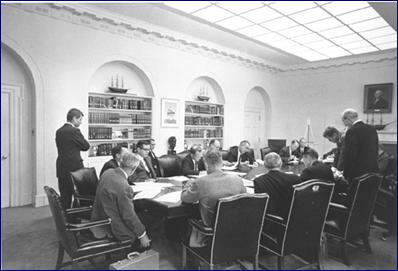VIII. Working Together
either log in or click here to purchase.
Log in here to access video.
Haven't purchased Eye of the Storm Leadership?
Starting Point / The Ex-Comm
All groups are vulnerable to failure but dysfunction comes in different ways and often invisibly. One group starts, sputters, and stalls for no observable reason. Another is hijacked by one or two dominators asserting power and influence. Others never rise to the challenge. They suffer from a lack of resources, uninspired leadership, sloppy organization, or an avoidance of responsibility. Sometimes, though, a powerful amalgamation of talent, energy, urgency, and dynamic leadership congeals and a group becomes great.
The date is October 15, 1962. The Cold War era between Russia and the U.S. is reaching a climax. Routine reconnaissance photos taken from an American U-2 spy plane over Cuba reveal Soviet surface-to-surface medium-range ballistic missiles and a launching facility under construction in a sugar cane field. President John F. Kennedy, two years into his presidency, is alerted and the next morning he calls his closest advisers to the White House. He shows them the photos, explains the international and domestic delicacy of the situation, and appoints a special Executive Committee of the National Security Council to wrestle out the issues, the validity and meaning of information, and the potential and often-shifting policy choices.
 An Air Force U-2, Similar to those Conducting Cuban Over Flights During the Cuban Missile Crisis. Credit: Wikimedia Commons.
An Air Force U-2, Similar to those Conducting Cuban Over Flights During the Cuban Missile Crisis. Credit: Wikimedia Commons.Ideas percolate. Maxwell Taylor and the Joint Chiefs of Staff advocate for immediate preemptive military strikes, recognizing that such actions could precipitate retaliatory attacks, possibly nuclear, against the U.S. and its allies in Europe. Adlai Stevenson and several others want to pursue a diplomatic course. Robert McNamara likes the idea of a blockade of Russian ships. The President’s closest and most trusted advisers in the group are his brother, Robert, and Ted Sorenson, his speech writer and political adviser. The two become Kennedy’s “eyes and ears� inside Ex-Comm and get together regularly before and after Ex-Comm meetings.
Inside Ex-Comm itself the debate is fierce and shifts repeatedly in response to the daily events that are cascading around them. On October 22, Kennedy goes public to the American people. He demands that the Soviets withdraw their missiles, orders a quarantine of Soviet shipments to Cuba, places U.S. forces on full alert, and warns the Soviet Union of full force reprisals to any missile launch. Two days later, Soviet Prime Minister Nikita Khrushchev replies. He puts the Soviet military on high alert and threatens to sink any U.S. ships that interfere with Russian ships heading to Cuba.
 President Kennedy and members of the Ex-Comm. Credit: Wikimedia Commons.
President Kennedy and members of the Ex-Comm. Credit: Wikimedia Commons.On October 25th six Russian ships heading for Cuba with weapons are stopped at the American quarantine line. Aided by photographic exposure of the Cuban missiles at the United Nations and various back channel diplomatic efforts, Kennedy agrees to retire obsolete U.S. missiles poised against Russia in Turkey. Khrushchev agrees to stand down from Cuba. The crisis ends. Of the Ex-Comm, Robert Kennedy would later write: “They were men of the highest intelligence, industriousness, courageous and dedicated to their country’s highest well-being.�[i] Wrestling with imperfect and sometimes erroneous information, they argued over political vs. military strategies and squarely confronted the risk of creating the world’s first nuclear war.
The Ex-Comm is an example of a “great group.� Under the right conditions, groups are capable of extraordinary things. They function as decision-markets, a time and space where sophisticated and creative value choices are built on prediction, coordination, and cooperation. James Surowiecki calls this “collective wisdom.� It is, he explains, why the many are inevitably smarter than the few and why independence, diversity of opinion, different sources of knowledge, and the means for turning private judgments into a collective aggregate will always produce a better result than the smartest expert working alone. We may admire the qualities of outstanding and exemplary thinkers and prize the achievements of individual experts but, in the long run, wolf packs survive longer (and eat better) than lone wolves.[ii]

71 Raw Material
Major John Reisman: “Shoot any officers you see in there.� Victor R. Franko: “Who? Ours or theirs?� From the 1967 film The Dirty Dozen.
 Miracle on Ice –Herb Brooks’ 1980 U.S. Olympic Hockey Team. Credit: Wikimedia Commons.
Miracle on Ice –Herb Brooks’ 1980 U.S. Olympic Hockey Team. Credit: Wikimedia Commons.
72 Symbiosis
“Respect your fellow human beings, treat them fairly, disagree with them honestly, enjoy their friendship, explore your thoughts about one another candidly, work together for a common goal and help one another achieve it.� Bill Bradley
|
|
This site managed with Dynamic Website Technology
from Mediate.com Products and Services |
